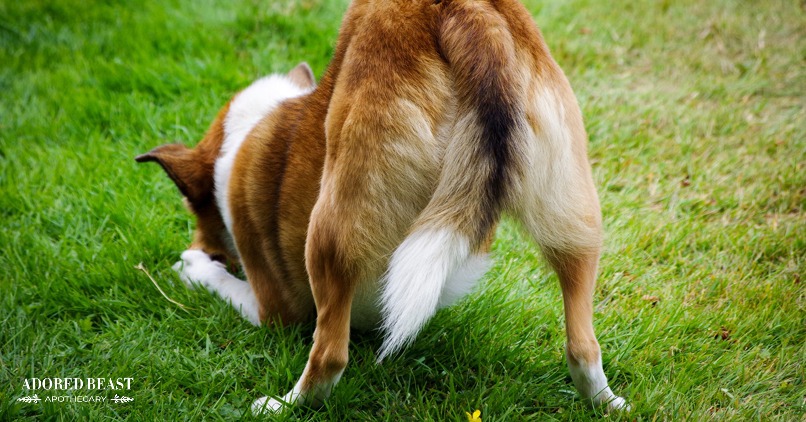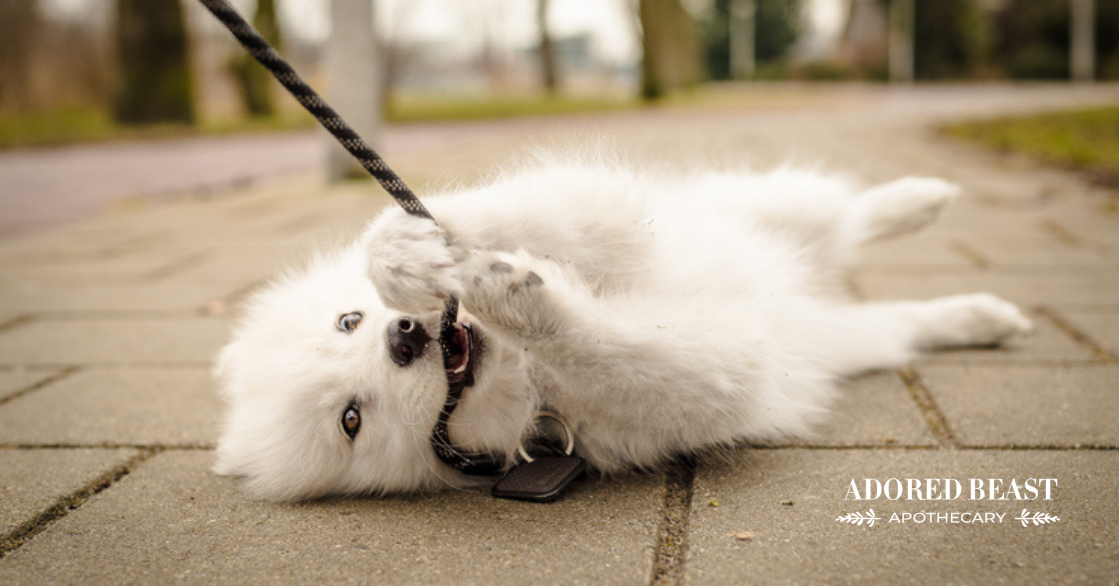We seem to get a lot of questions about anal glands and anal gland issues here at Adored Beast. And to me that makes a lot of sense – the anal glands are finicky things, and many dogs do have issues.
Sometimes it’s just a one-time thing. For other dogs, the anal glands are a constant source of pain and irritation.
In my experience though, there are really simple ways to help keep a dog’s anal glands healthy.
Today I want to talk about what these little glands do, some of the most common anal gland issues, and how you can work holistically to support them.
What are the Anal Glands?
The anal glands are two small, oval-shaped sacs located beside your dog’s anus. These glands produce a fluid with a strong odour that’s unique to each dog. When all is right with the world, these glands empty when your dog (or cat) poops. They have a little sphincter, and when your dog poops, the holes open and close, and the sacs empty as a result.
Anal glands are really important, from a perspective of what they do. Their primary function is tracking and scenting. In the wild, they’re how wolves mark their territory to warn other animals to stay out. With dogs, it’s the same. They’re a major form of communication between animals. In fact, it’s part of the reason dogs sniff each other’s butts! It’s the headline of the newspaper. Urine does this as well, but the anal glands really identify so much about an animal: their sex, if they’re sick, their approximate age, if the dogs have met before. It’s such an important thing. It’s what makes dogs so happy to smell the ground and other dogs’ poop 🙂
Common Anal Gland Issues
There are several common anal gland issues.
1. Impacted Anal Glands
When it comes to anal gland issues, impacted anal glands are the biggest, for sure. This happens when that fluid builds up and can’t get out on its own.
In my opinion, the reason the anal glands become impacted to begin with is because a dog’s stool (and cats’ too) were never meant to be uniform. Like when people say “they’re these nice little, perfect poops,” that’s not a good thing! They’re not supposed to be nice little, perfect poops. They’re supposed to have bumps and lumps of what they’re digesting when they poop. And when these lumps and bumps travel through and out, they massage the anal glands, and the anal glands express.
In my experience, when animals are on processed food, their stools are too soft, and they cannot massage those glands to express them. Not enough exercise, which helps with digestion, can also cause the anal glands to become impacted, as can a diet that doesn’t have enough fibre or doesn’t provide the right digestive enzymes to the gut. Solid, lumpy poops are key!
2. Inflammation of the Anal Glands
Inflammation of the anal glands is another problem. This can stem from food allergies and sensitivities. If a dog or cat has allergies and licks their bum a lot, or is scooting, that inflammatory response can also make those glands swell up, and then the sphincter becomes tight and stretched, making it hard to excrete the fluid, which then becomes a thick consistency, leading to anal gland impactions.
Additionally, once anal glands become impacted, they can become infected.
3. Scarring of the Anal Glands
Something that doesn’t get talked about enough is scarring. When dogs have their anal glands expressed, and many groomers and veterinarians will routinely do this, scar tissue can build up. Think about it like squeezing a pimple. Just like with that pimple, you keep squeezing it and squeezing it and it just gets so inflamed and becomes hard and scars. Then nothing can come out! Then the anal glands can’t express on their own anymore and you find yourself and your dog stuck in a vicious cycle of vet visits, antibiotics, anti-inflammatories, and even steroids.
4. Anal Gland Tumors
Anal gland adenocarcinoma/anal gland tumors are two other, far less common issues (cancer and tumors in the anal glands), so if your animal is having chronic anal glad issues please be aware and ask your veterinarian to be mindful in checking this out.
Supporting Anal Gland Health Holistically
The anal glands just need a little TLC and they’re happy and healthy.
First of all, you need to pay attention to your dog’s poops. If they’re too soft, and you can easily tell, they’re more apt to have anal gland issues.
If you notice they’re soft, a good first step is to increase the amount of bone in the diet. Switching to a raw food diet with ground bone in it is a good way to achieve this. Already feed raw with ground bone? Add extra bone. The best kind of bone, in my experience, if a dog isn’t allergic to poultry, is a neck bone: chicken necks, turkey necks, duck necks. Neck bones are the bones that I’ve found work the fastest for anal glands.
I prefer soft bone compared to hard bones, because you want to create calcified pieces in the poop. You don’t want a poop coming out looking like white rock – that’s way, way, way too much bone and that can be painful. What you do want is poop coming out with pieces of almost like hardened calcium among the regular formed poop.
If your dog or cat is allergic to poultry, oxtail is a great alternative. It’s a little softer than, say, a femur. It’s something else that the body can digest easily.
Tip: Never start with a large amount of bone or you’re going to get a constipated dog, 1000%.
Sometimes more fiber is also needed. Leafy greens, squash, and pumpkin are all good choices. There are lots of ideas at this post.
Finding the correct consistency is important, and sometimes it isn’t just bone or fiber. Sometimes it’s just that the digestive tract isn’t digesting correctly. In this case, you may want to try some digestive enzymes, or some specific probiotics. But I would say digestive enzymes first.
For more on raw bones, check out this post.
Small/toy breeds tend to be more susceptible to anal gland issues, so pay extra attention to their little poops. I think this is because their little jaws can’t typically chew on big bones very easily. If you and your small dog are just new to raw and you’re concerned that they’re going to swallow it and choke, put a strong rubber glove on and hold it while they chew. Ideally, you hold it and move it around their mouth so they get the benefit of the bone. Plus, it really, really helps clean their teeth!
Tip: If your dog is new to bones, to help decrease the chance of constipation, on the day you feed bone you can also feed more fiber and bone broth! This increases the moisture.
Natural Remedies for Anal Gland Issues
Try to start with bone. Every dog is different, so it might take a day, it might take 2-3 days. Give it time to work. Watch that poop and if they are licking or scooting less. If this seems to clear things up, you know you’re on the right track and can adjust the diet accordingly.
Next, there are 4 remedies we used in my clinic:
- Aconite
- Arnica
- Silica
- Hepar Sulph
For reducing inflammation and pain, aconite and arnica are amazing. Some dogs will stop pooping because their bum hurts, and you really don’t want that. Our Your Go2 (aconite and arnica) is great for this.
Silica is incredibly helpful to support the body in pushing out anything that’s foreign.
Hepar sulph is a great remedy if the impacted anal glands are infected. If it’s painful and infected, add this. If it isn’t painful, just go with the other 3.
Give arnica 200C and aconite 200C 3 times a day for 1 day, then silica 12C or 30C three times a day for up to 10 days. Add hepar sulph 30C (if needed) three times a day for the first 3-5 days.
Tip: With silica, you don’t want to go any higher than 30C for impacted anal glands. High potency silica helps the body resolve something, whereas low potency pushes things out (which is what you want).
You can also apply a compress with green and chamomile tea to the anal glands to help soothe them. An epsom salt compress may also help. Let your dog choose warm or cold. Some will want warm, some will want cold. Warm will help express the glands by drawing out the fluid but cold can help bring down the inflammation and soothe it. Sometimes starting with cold and switching to warm is the best solution.
It never hurts to put a drop of CBD oil onto the glands themselves as well to decrease pain and inflammation.
If their glands are really painful, sometimes you will have to go to the vet!! And that’s ok! 100% go. Just support the body afterwards and start fresh after everything is healed up, get that bone in the diet, along with those digestive enzymes.
Should You Remove the Anal Glands?
Some veterinarians will suggest removing a dog’s anal glands if the issues are chronic and just keep happening. But I’m sure you can guess my stance on this. I’m not a fan of manually expressing the anal glands and I’m definitely not a fan of removing them.
Everything is in a body – whether it’s a dog, cat, horse, pig, human, doesn’t matter – for a reason. As I said before, the anal glands are so important to how your dog views the world and communicates with other animals. Just removing something because it’s a “pain in the ass” (literally) is completely not my philosophy.
You don’t want to risk your dog getting a tumor from them constantly being inflamed and constantly being manually expressed, so there is some relevance to this, but in general, no I don’t agree with removing them. In my 20 years of practice we never had a patient who we were unable to help recover, even from reoccurring chronic issues. Therefore, we never had a patient who had to have them removed. In my opinion, I would do everything in my power to prevent removal.
With a little love and attention, you can support your animal’s communication and overall health while protecting the glands and preventing anal gland issues from happening.












![[RESEARCH] Is Herbicide Safe for Dogs?](https://blog.adoredbeast.com/wp-content/uploads/2025/06/herbicides-safe-for-dogs-103x55.png)